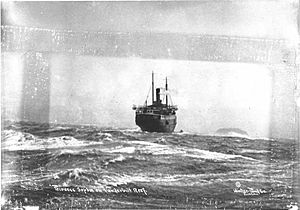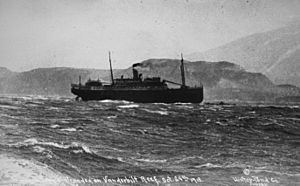SS Princess Sophia facts for kids
class="infobox " style="float: right; clear: right; width: 315px; border-spacing: 2px; text-align: left; font-size: 90%;"
| colspan="2" style="text-align: center; font-size: 90%; line-height: 1.5em;" | 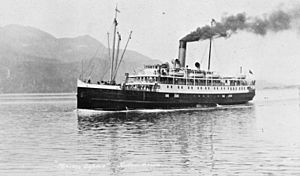
|} SS Princess Sophia was a large steel passenger ship. It was part of the Canadian Pacific Railway (CPR) fleet. The Princess Sophia was one of four similar ships built for CPR between 1910 and 1911.
On October 25, 1918, the Sophia sank. It hit Vanderbilt Reef near Juneau, Alaska. All 364 people on board died. This made the sinking of the Sophia the worst sea accident in the history of British Columbia and Alaska.
Contents
- Exploring the Inside Passage
- What was a Coastal Liner?
- Building the Princess Sophia
- Ship Routes and Service
- The Final Voyage
- Vanderbilt Reef: A Hidden Danger
- Navigation Lights and Stations
- The Ship Hits the Reef
- First Call for Help
- Stuck on the Reef
- Similar Shipwrecks in Mind
- Decision Not to Evacuate
- Communication Problems
- Rescue Efforts on Friday Morning
- Rising Winds Force Retreat
- Last Call for Help
- Searching in the Storm
- The Ship is Lost
- Wreck Found
- Aftermath of the Wreck
- Should They Have Evacuated?
- Letters from Lost Passengers
| History | |
|---|---|
| Name | Princess Sophia |
| Owner | Canadian Pacific Railway (CPR) |
| Port of registry | |
| Route | Vancouver and Victoria to northern British Columbia ports and Alaska |
| Ordered | May 1911 |
| Builder | Bow, McLachlan & Co, Paisley, Scotland, UK |
| Cost | £51,000 (about $250,000 at that time) |
| Yard number | 272 |
| Launched | 8 November 1911 |
| Christened | By the daughter of Arthur Piers, manager of C.P. Steamship Service |
| Completed | 1912 |
| Maiden voyage | 7 June 1912 |
| Fate | Grounded on 24 October 1918; sank following day during a storm |
| General characteristics | |
| Type | Coastal passenger steamship |
| Tonnage |
|
| Length | 245 ft (75 m) |
| Beam | 44 ft (13 m) |
| Draught | 12 ft (4 m) |
| Depth | 24 ft (7 m) depth of hold |
| Installed power | One triple expansion steam engine, 22", 37", and 60" x 36" |
| Propulsion | Single screw |
| Speed | 14 knots (26 km/h) |
| Capacity | 250 passengers; could carry more with special permission (capacity for 500) |
| Crew | 73 |
| Notes | Originally coal-burning; converted to oil fuel shortly after arrival in British Columbia |
- Wednesday, October 23, 1918
- Thursday, October 24, 1918
- Friday, October 25, 1918
- Saturday, October 26, 1918
Exploring the Inside Passage
Since 1901, the Canadian Pacific Railway (CPR) ran a fleet of steamships. These ships traveled along the west coast of Canada and southeast Alaska. The main route started in Victoria and Vancouver, British Columbia. It went through winding channels and fjords. The ships stopped at towns to drop off passengers, cargo, and mail. This route is still important today and is called the Inside Passage.
Major stops along the Inside Passage included Prince Rupert and Alert Bay in British Columbia. In Alaska, stops included Wrangell, Ketchikan, Juneau, and Skagway.
What was a Coastal Liner?
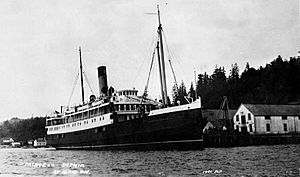
Many types of ships sailed the Inside Passage. But the "coastal liner" was the most common for longer trips. A coastal liner was a ship that could handle rough ocean conditions if needed. However, it usually operated in calmer coastal waters. For example, Princess Sophia was only allowed to carry passengers within 50 nautical miles of the coast.
Coastal liners carried both people and goods. They were often the only link for isolated coastal towns to the outside world. Early coastal liners were made of wood. But after several shipwrecks showed how weak wooden hulls were, CPR started building all new ships from steel.
The Sophia was also called a "pocket liner." This meant it had fancy features like a big ocean liner, but on a smaller scale. The ship was part of the CPR "Princess fleet." All ships in this fleet had names starting with "Princess."
Building the Princess Sophia
The Princess Sophia was a steamship built in Scotland. It weighed 2,320 gross tons. It was a strong ship, made of steel with a double hull. This design meant it could handle tough conditions. The Sophia was also equipped with wireless communication and full electric lighting.
While not as fancy as some other ships in its fleet, the Sophia was very comfortable. Especially for first-class passengers. It had a front lounge with maple wood panels. There was also a social hall with a piano. The dining room had 112 seats and big windows to see the coastal views.
The Sophia was launched in November 1911 and finished in 1912. Captain Albert Adolphus Lindgren sailed it around Cape Horn to British Columbia. At first, the Sophia burned coal. But it was soon changed to use oil fuel after arriving in British Columbia. When it sank, Captain Leonard Locke was in command. Captain Jeremiah Shaw was the second in command.
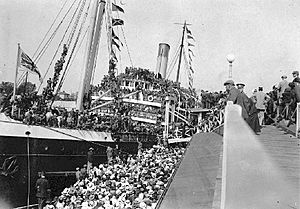
Ship Routes and Service
When the Sophia arrived, it sailed from Victoria to Prince Rupert. The next summer, CPR used it for trips every two weeks. These trips went from Victoria to Skagway, Alaska. It would stop in Prince Rupert along the way. Sometimes, the Sophia went on other routes, like a trip to Bellingham, Washington.
When Canada joined the Great War in 1914, business for CPR ships slowed down. Some ships, including the Sophia, were temporarily taken out of service. However, the Sophia and other CPR ships later helped transport troops for the war in Europe.
On September 12, 1918, the Sophia hit the patrol vessel USFS Auklet. This happened while the Auklet was docked in Juneau, Alaska. The Auklet was badly damaged.
The Final Voyage
On October 23, 1918, Princess Sophia left Skagway, Alaska, at 10:10 PM. It was more than three hours late. It was supposed to stop in Juneau and Wrangell, Alaska, the next day. Then Ketchikan, Alaska, and Prince Rupert on October 25. After that, Alert Bay on October 26, and Vancouver on October 27.
On board were 75 crew members and about 268 passengers. These included families of soldiers, miners, and crews from other ships. Fifty women and children were on the ship. This included the family of gold investor John Beaton.
Four hours after leaving Skagway, the Sophia was sailing south down Lynn Canal. It ran into heavy, blinding snow and strong winds. Captain Locke sailed the canal at full speed. He might have been trying to make up for lost time. Because of the snow, the crew used a method called dead reckoning. They blew the ship's whistle and calculated their location based on the echo. The ship was at least one nautical mile off course.
Vanderbilt Reef: A Hidden Danger
Ahead of the Sophia was Vanderbilt Reef. This was the top of an underwater mountain. It rose 1,000 feet from the bottom of Lynn Canal. At high tide, the rock could be hidden by waves. At low tide, it looked like a low table. Its highest point was 12 feet above the water at very low tide. At the time of the accident, Vanderbilt Reef was at very high tide and had no lights.
The channel here was about 6.5 miles wide. But the reef narrowed the main path to 2.5 miles on its east side. This area is dangerous for ships. It has deep waters, strong currents, rocky cliffs, and narrow fjords. Tides often push ships dangerously close to shore. In bad weather, winds in the canal quickly become gales.
Vanderbilt Reef itself had an unlit buoy. This buoy would have been invisible at night. There was a lighthouse with staff at Sentinel Island, about 4 miles south. This light station had a sheltered area for its dock. The Princess Sophia also passed another manned light station at Eldred Rock, 30 miles south of Skagway.
Keepers at both light stations recorded weather conditions. These records later helped understand what happened. The dock at Sentinel Island was used by rescue ships on October 24 and 25, 1918.
The Ship Hits the Reef
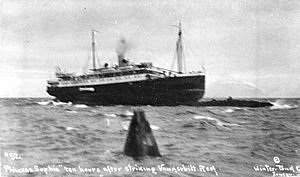
Heading south, Princess Sophia drifted about 1.25 miles off course. At 2:00 AM on October 24, 1918, the Princess Sophia hit Vanderbilt Reef hard. This was 54 miles south of Skagway. A letter found later from a passenger, Private Auris W. McQueen, described the scene: "Two women fainted... Some of the men, too, kept life preservers on for an hour or so and seemed to think there was no chance for us."
First Call for Help
The wireless operator on Princess Sophia sent a distress call right away. Wireless signals were weak back then. The signal could not reach much farther than Juneau. But it did reach Juneau. By 2:15 AM, the local CPR shipping agent was woken up. He immediately started organizing rescue boats from the harbor.
Stuck on the Reef
High tide came at 6:00 AM on October 24. The wind had lessened, but Princess Sophia was still stuck fast on the reef. Low tide came around noon. The wind and waves pushed Princess Sophia even further onto the reef. Luckily, the ship's double hull was not broken. At low tide, the entire hull of Princess Sophia was completely out of the water. The weather seemed to be getting better.
With the next high tide at 4:00 PM, and the seas still rough, Captain Locke decided to wait. He hoped he could get the ship off later. But this was not possible. Without a tug, or even two or three, Princess Sophia could not be moved. Worse, passengers could not be safely taken off the ship. At low tide, Princess Sophia was surrounded by exposed rock. At high tide, the rock was covered, but waves were so strong that a lifeboat would hit the rocks.
Similar Shipwrecks in Mind
Captain Locke and other rescue captains remembered two past shipwrecks. These were the Clallam in 1904 and the Princess May in 1910. They showed the difficult choice Captain Locke faced about evacuating the Princess Sophia.
On August 5, 1910, the Princess May, another CPR ship, ran aground on Sentinel Island. This was near Vanderbilt Reef. All people on board were safely taken to the nearby light station. The ship itself was later removed with only minor damage. CPR sent the Princess May to pick up Sophia's passengers, expecting them to be evacuated soon.
The Clallam disaster showed the dangers of leaving a ship too early. The Clallam sank in a storm on January 8, 1904. Captain Roberts ordered lifeboats lowered. Most of the people put into them were women and children. All three boats either flipped over or failed to launch correctly. All 54 people in them drowned. The Clallam stayed afloat long enough for rescue ships to arrive and save the remaining people.
Decision Not to Evacuate
Captain Locke warned off James Davis, captain of the fishing boat Estebeth. Davis tried to reach the Sophia in a small boat but gave up. Davis tied his boat to the Vanderbilt Reef marker buoy. This was on the side of Princess Sophia protected from the worst weather. The situation was clearly desperate.
Princess Sophia was badly damaged. It had a hole in its bow where water flowed in and out. Davis estimated it was 200 or 300 gallons per minute. Since there was no safe way to evacuate passengers, the rescue boats could only wait. They hoped the weather would calm down enough to try a rescue. Captain Locke felt his ship was safe enough. He told Estebeth and Amy to find shelter in a harbor.
Captain J. W. Ledbetter, commander of the lighthouse tender USLHT Cedar, did not hear about the grounding until 2:00 PM on October 24. He was 66 miles away. Ledbetter contacted Captain Locke by wireless. He asked if Locke wanted to try to evacuate passengers that night. Locke said the wind and tide were too strong. He thought it would be better for rescue ships to anchor and wait until daylight. When Ledbetter arrived at 8:00 PM on October 24, he found three large ships and about fifteen smaller fishing boats.
Meanwhile, news of the grounding reached James W. Troup, CPR's steamship superintendent in Victoria. He and other CPR officials were not too worried at first. They thought passengers would be taken off soon.
Communication Problems
Cable communications to Alaska had been lost on October 21, 1918. Because of this, wireless operators were dealing with many messages. This made it hard to send important messages about the Princess Sophia. Efforts to clear unimportant messages failed because the disaster involved two countries. The Cedar did not get the news until eleven hours after the grounding. It is unclear if this was because Cedar was too far away or if wireless channels were too busy. This delay was unfortunate. The Cedar was the largest all-weather ship nearby. It could have taken all of Princess Sophia's passengers and crew. No one knows what Cedar could have done if it had been alerted earlier. The delay was still remembered by Captain Ledbetter 45 years later. Of all the rescue ships, only Cedar had wireless. Its late arrival meant this resource was not available earlier.
Rescue Efforts on Friday Morning
Ledbetter, whose ship had the only wireless, organized the rescue. The plan was risky. They would wait until high tide at 5:00 AM. This would cover the reef with a few feet of water. They hoped this would be enough to launch Sophia's boats. These boats would then take people to the rescue ships.
The Cedar had anchored behind a nearby island for the night. The King and Winge, led by Captain J.J. Miller, had circled Princess Sophia all night. When Ledbetter arrived at 8:00 PM on Thursday, he shone searchlights on Princess Sophia. What he saw convinced him that no boats could be launched. Waves were crashing hard against the ship. The wind was getting stronger. The stranded ship remained stuck firmly on the rocks. Ledbetter, Miller, and Locke all agreed that passengers would be safer on Princess Sophia. They put off any attempt to take them off by boat.
Rising Winds Force Retreat
By 9:00 AM on October 25, the wind was reaching gale strength. Ledbetter was having trouble keeping the Cedar in place. The smaller rescue boats that had sought shelter on October 24 could not return to the reef. Ledbetter decided to try to anchor the Cedar about 500 yards downwind of the reef. He planned to shoot a line to Princess Sophia and evacuate passengers by breeches buoy. This would have been very dangerous. It was unlikely that over 300 people could be removed this way. But it seemed like the only option.
Ledbetter tried to drop anchor twice, but it failed to catch. Locke saw this was not working. He radioed Ledbetter that it was no use. They would have to wait for low tide, hoping conditions would improve. There was nothing else to do.
Conditions got steadily worse. By about 1:00 PM on the 25th, both Cedar and King and Winge were having trouble staying near the reef. Ledbetter radioed Locke and asked permission to move to a more protected area. Locke agreed. Cedar and King and Winge then went to the sheltered side of Sentinel Island. There, Captain Miller of King and Winge boarded Cedar to discuss a rescue plan with Ledbetter.
They agreed that King and Winge would anchor near the reef. It carried a 350-fathom anchor cable. Meanwhile, Cedar would stay windward of King and Winge. This would create a calm spot by blocking the wind. Cedar would then launch its lifeboats to pick up people from Princess Sophia. They would ferry them to King and Winge. This would avoid using the stranded ship's boats. However, this plan could only work if the weather improved. Since Princess Sophia had so far survived the pounding waves, Ledbetter and Miller felt it was better to wait until the next day.
Last Call for Help
Just as Miller was leaving Cedar to return to King and Winge, at 4:50 PM on October 25, Princess Sophia sent a wireless message: "Ship Foundering on Reef. Come at Once." Ledbetter immediately prepared to steam to the reef. He signaled Miller on King and Winge to follow him. Miller did not understand at first. Ledbetter then drove Cedar next to King and Winge and shouted to Miller: "I am going out there to try to locate him. If the snow should clear up, you come out and relieve me." Miller replied: "I will give you an hour to find them."
One of the last distress messages, at 5:20 PM, was from wireless operator David Robinson. It said, "For God's sake hurry, the water is coming into my room." Knowing Princess Sophia had weak wireless batteries, Cedar told the ship to save power. They should only transmit if absolutely necessary. Princess Sophia's operator radioed back: "Alright I will. You talk to me so I know you are coming." This was the last wireless message from Princess Sophia.
Searching in the Storm
Cedar left the protected harbor at Sentinel Island. It was immediately hit by strong winds and blowing snow. Conditions were so bad that 500 yards from the lighthouse, its light could not be seen. The foghorn could not be heard. For 30 minutes, Cedar moved slowly towards Vanderbilt Reef. Green water was breaking over the bow of Cedar. Without knowing exactly where it was, the rescue ship itself was in extreme danger of hitting the reef.
The chief inspector of the lighthouse service district was on board Cedar. He and Ledbetter agreed that with Cedar in danger and nothing to be found, they had to seek shelter. Ledbetter turned Cedar back towards Sentinel Island. Unable to see anything, he sounded the foghorn. At Sentinel Island, Captain Miller on King and Winge heard the blasts. He sounded his own to guide them in.
David Leverton of the Maritime Museum of British Columbia said the captain's barometer predicted better weather. It suggested rescuers try the next day. "They had seven different rescue ships ready to come to the aid of the ship if it foundered off the reef. But what ended up happening was that it settled down on the reef" until about 5 PM when it was lifted off the reef.
The Ship is Lost
There were no survivors or witnesses to the actual sinking. What happened to drive Princess Sophia off the reef is based on evidence and guesses. It seems the storm, blowing from the north, raised water levels on the reef. This caused the ship to become buoyant again, but only partly. The bow stayed on the reef. The force of the wind and waves then spun the ship almost completely around. It was washed off the reef. Dragging across the rock tore out the ship's bottom. So, when it reached deeper water near the navigation buoy, it sank. This process seems to have taken about an hour.
There appears to have been no time for an organized evacuation. Many people wore lifejackets. Two wooden lifeboats floated away (the eight steel lifeboats sank). About 100 people were still in their cabins when the ship sank. It is hard to know why, if the ship took half an hour to sink, so many people were below decks. It was believed that seawater flooded the ship and the boiler exploded. But divers found all three boilers intact. Oil fuel spilled into the water, choking people trying to swim away. Sophia had extra flotation devices. But these were useless. The cold seawater would kill a swimmer long before rescue could arrive.
Wreck Found
The next morning, October 26, it was still snowing, but the wind had calmed down. Cedar, King and Winge, and other rescue ships returned to the reef. Only the foremast of Princess Sophia was still above water. The rescue ships searched for three hours for survivors. They found bodies, but no living people. King and Winge took the bodies to Juneau. Cedar also returned to Juneau. When he arrived, Captain Ledbetter sent a message: "No sign of life. No hope of survivors."
Watches found on bodies stopped at 5:50 PM. This suggests that by this time, Sophia had sunk. The only survivor was an English setter dog found in Auke Bay, outside Juneau.
Aftermath of the Wreck
For months after the wreck, bodies washed up for as much as thirty miles north and south of Vanderbilt Reef. Wreckage and passengers' belongings were also found, including children's toys. Many bodies were hard to recognize, covered in thick oil. Among the dead was Walter Harper, the first person to reach the top of Denali, North America's highest mountain.
Most bodies were taken to Juneau. Many local citizens helped identify the remains and prepare them for burial. The bodies had to be scrubbed with gasoline to remove the oil. Volunteers were especially affected by the bodies of the children. Divers at the wreck site found about 100 bodies. Many floated in cabins for months. Families of passengers sued Canadian Pacific, but they did not win.
Should They Have Evacuated?
Many people believed that Captain Locke's decision not to evacuate the ship was a big mistake. They thought most or all passengers could have been saved. The Ministry of Marine agreed in 1919 after hearing witnesses. Later, courts ruled that Locke's decision was reasonable for a captain.
Captain Ledbetter of Cedar said he never saw conditions that would have allowed evacuation. But he was careful to say this was only from when he arrived at 8:00 PM on October 24. As early as 10:20 AM on October 24, enough rescue ships were at the reef to take all people from Princess Sophia. There were four or five hours before the wind started to get stronger. Also, Princess Sophia had eight steel lifeboats, not wooden ones. These might have done better on the waves.
However, Captain Locke could not have known the weather would get worse. There were signs it might improve. Historians Coates and Morrison think the memory of the Clallam wreck might have influenced Locke's decision. In that case, everyone in the lifeboats died after leaving the ship too early.
Letters from Lost Passengers
Passengers and crew on Princess Sophia knew they were in great danger. Many wrote letters to loved ones. At least two of these were found later. A letter from John R. "Jack" Maskell, found on his body, was printed in newspapers:
Shipwrecked off coast of Alaska
S.S. Princess Sophia
October 24, 1918
My own dear sweetheart,
I am writing this my dear girl while the boat is in grave danger. We struck a rock last night which threw many from their berths, women rushed out in their night attire, some were crying, some too weak to move, but the lifeboats were swung out in all readiness but owing to the storm would be madness to launch until there was no hope for the ship. Surrounding ships were notified by wireless and in three hours the first steamer came, but cannot get near owing to the storm raging and the reef which we are on. There are now seven ships near. When the tide went down, two-thirds of the boat was high and dry. We are expecting the lights to go out at any minute, also the fires. The boat might go to pieces, for the force of the waves are terrible, making awful noises on the side of the boat, which has quite a list to port. No one is allowed to sleep, but believe me dear Dorrie it might have been much worse. Just hear there is a big steamer coming. We struck the reef in a terrible snowstorm. There is a big buoy near marking the danger but the captain was to port instead [of] to starboard of [the] buoy. I made my will this morning, leaving everything to you, my own true love and I want you to give £100 to my dear Mother, £100 to my dear Dad, £100 to dear wee Jack, and the balance of my estate (about £300) to you, Dorrie dear. The Eagle Lodge will take care of my remains.
In danger at Sea.
Princess Sophia
24th October 1918
To whom it may concern:
Should anything happen [to] me notify, notify Eagle Lodge, Dawson. My insurance, finances, and property, I leave to my wife (who was to be) Miss Dorothy Burgess, 37 Smart St., Longsight, Manchester, England.
J. Maskell
Jack Maskell was buried in Vancouver's Mountain View Cemetery. He rests with 66 other victims of the Princess Sophia tragedy. Most are near East 41st Avenue and Prince Edward Street.
Timeline of the Disaster
Wednesday, October 23, 1918
- 8:15 AM: Snow starts falling at Sentinel Island Light Station (58 miles south of Skagway). It snows until 6:50 AM on October 24.
- 11:10 AM: Snow starts falling at Eldred Rock Light Station (30 miles south of Skagway). It snows until 6:00 AM on October 24.
- 4:33 PM: Sunset in Juneau.
- 5:14 PM: Night begins in Juneau.
- 7:01 PM: Moonrise (Moon is 79% full).
- 10:00 PM: Princess Sophia leaves Skagway, Captain Locke in command.
- 11:00 PM: Sophia passes Battery Point (16 miles south of Skagway). Weather gets worse, wind gusts up to 50 miles per hour.
Thursday, October 24, 1918
- 2:10 AM: Princess Sophia hits Vanderbilt Reef (54 miles south of Skagway, 46 miles north of Juneau).
- 2:15 AM: News of the grounding reaches Juneau by wireless distress call.
- 6:00 AM: High tide at Vanderbilt Reef. Sophia's hull hits rocks. Storm lessens, but the ship cannot get free. The first rescue ship arrives. Snowfall stops at Eldred Rock Light Station.
- 6:12 AM: Dawn begins.
- 6:50 AM: Snowfall stops at Sentinel Island Light Station (4 miles south of Vanderbilt Reef). Weather stays clear until 12:10 PM.
- 6:53 AM: Sunrise.
- 9:00 AM: U.S. harbor boat Peterson arrives at Vanderbilt Reef.
- 10:00 AM: Mailboat Estebeth arrives at Vanderbilt Reef.
- 10:20 AM: Amy arrives at Vanderbilt Reef. Rescue ships now have room for more than 385 people, which is more than on Sophia.
- 12:00 PM: Low tide at Vanderbilt Reef.
- 12:10 PM: Snow starts falling again at Sentinel Rock Light Station. It continues until 3:40 AM on Sunday, October 27.
- 1:00 PM: Snow starts falling again at Eldred Rock Light Station. It continues until 8:00 AM on October 27.
- 2:00 PM: Wireless message from Juneau alerts Captain John Ledbetter of the lighthouse tender Cedar. Cedar is 66 miles south of Vanderbilt Reef. Cedar immediately heads to Vanderbilt Reef. It arrives six hours later at 8:00 PM.
- 3:00 PM: Wind starts getting stronger at Vanderbilt Reef.
- 3:30 PM: Ferry boat Lone Fisherman arrives at Sentinel Island (does not go to the reef).
- 4:00 PM: High tide at Vanderbilt Reef. Sophia cannot break free. Seas are rough, and waves hit the hull as the tide rises. Since Sophia is not badly damaged, Captain Locke tells Amy and Estebeth to find shelter. They do. Sitka arrives at the reef.
- 4:30 PM: Sunset.
- 5:11 PM: Night begins.
- 6:20 PM: King and Winge arrives at the reef. It stays there until 1:00 PM on October 25.
- 7:00 PM: Elsinore arrives at the reef.
- 8:00 PM: Cedar arrives at the reef. Wireless communication is now possible between rescue ships and Sophia.
- 8:15 PM: Moonrise (Moon is 69% full).
- 8:30 PM: Light and heat are lost on Sophia. This makes King and Winge temporarily think the ship has sunk. Loss of power causes loss of wireless communication.
- 7:00 PM: Cedar departs Vanderbilt Reef.
- 11:30 PM: Princess Alice leaves Vancouver, BC, heading for Juneau. It plans to pick up passengers expected to be evacuated from Sophia.
Friday, October 25, 1918
- 4:35 AM: Cedar returns to Vanderbilt Reef. King and Winge has been there all night. Rescue efforts are delayed because of sea conditions.
- 6:14 AM: Dawn's first light.
- 6:55 AM: Sunrise.
- 8:00 AM: Electrical power and steam heat are back on Sophia. Wireless communication is possible again.
- 9:00 AM: Cedar tries to anchor and evacuate passengers by breeches buoy. The attempt to anchor fails.
- 10:00 AM: Locke radios Ledbetter, telling him to stop trying to anchor and wait until the next low tide.
- 1:00 PM: Worsening weather forces Cedar and King and Winge to leave the reef. They get permission from Locke first.
- 1:45 PM: Cedar and King and Winge reach calmer water behind Sentinel Island. Tired wireless operators on Cedar and Sophia agree not to talk until 4:30 PM to rest.
- 4:47 PM: Sunset.
- 4:50 PM: Sophia radios Cedar: "Ship foundering on reef. Come at once." Cedar heads to Vanderbilt Reef but cannot find the ship.
- 5:09 PM: Night begins.
- 5:20 PM: Last wireless message from Sophia.
- 5:50 PM: Most watches found on Sophia victims stop. It is believed that by this time, Sophia had sunk, and people were in the water. No one on board survives.
Saturday, October 26, 1918
- 6:16 AM: Dawn's first light.
- 6:58 AM: Sunrise.
- 7:21 AM: Cedar leaves Sentinel Island to return to the reef to search.
- 8:30 AM: Cedar arrives at the reef and sees only the foremast of Sophia above the water on the south side of the reef.
Images for kids
See also
 In Spanish: SS Princess Sophia para niños
In Spanish: SS Princess Sophia para niños


